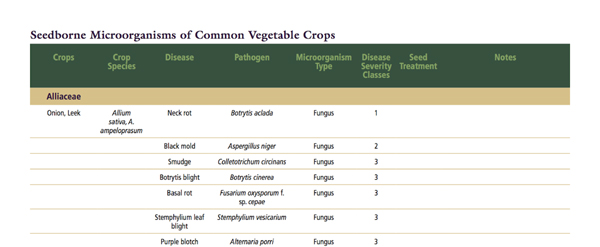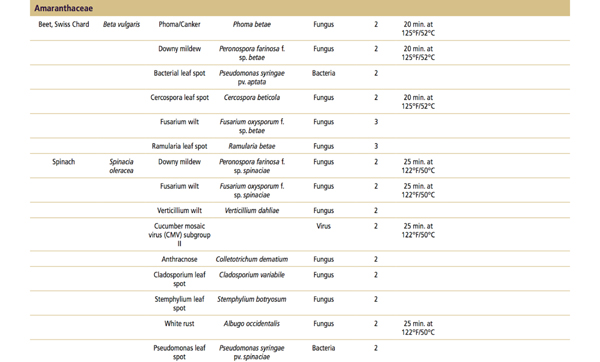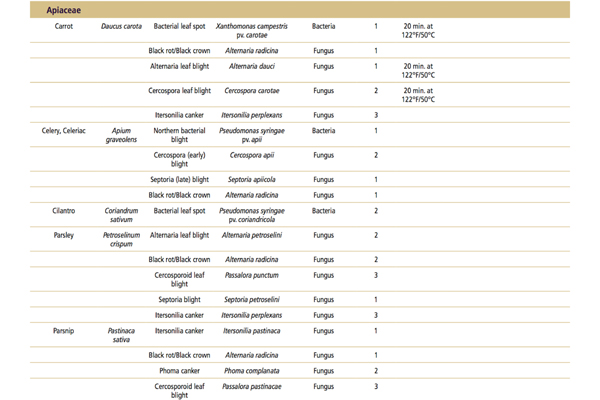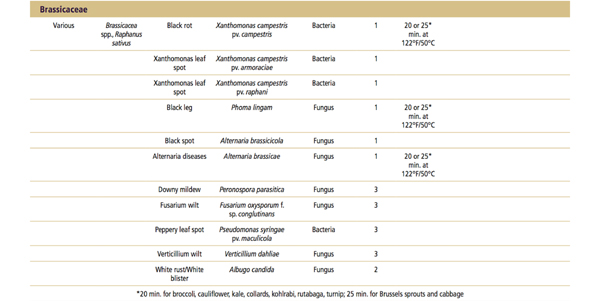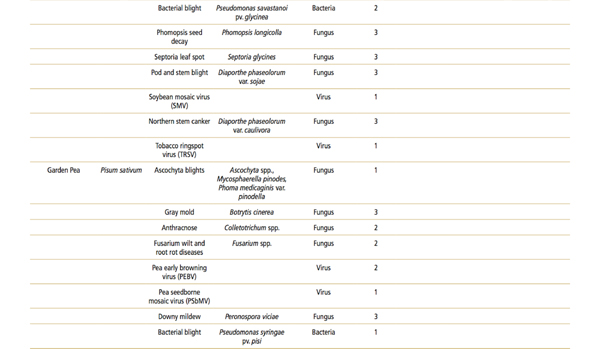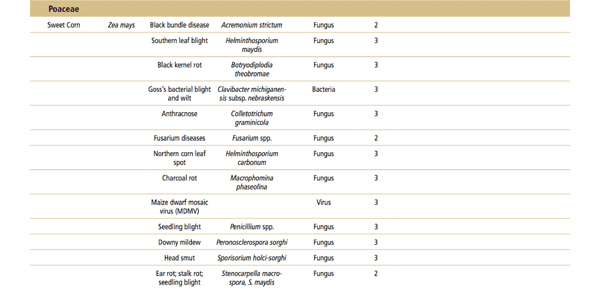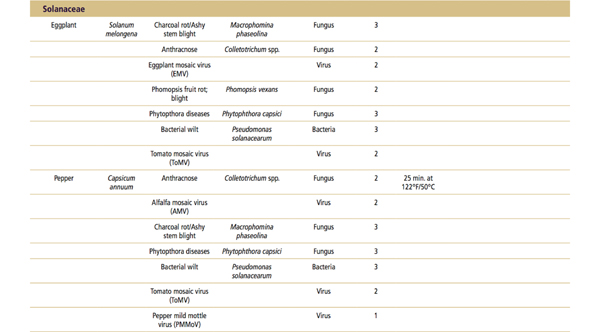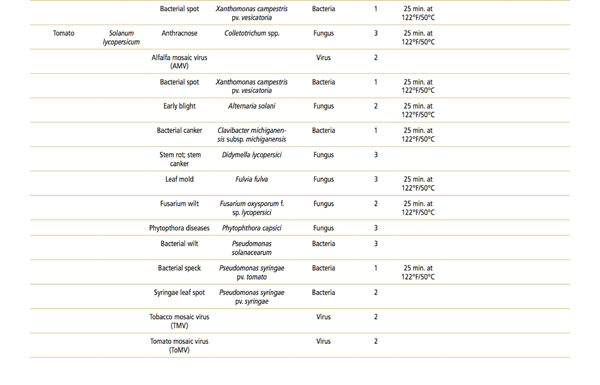A number of risks are inherent in all agricultural endeavors. One of these, when growing crops, is the threat of disease. For all farmers, diseases of their crops are something that should be identified, monitored, and possibly controlled through various organically acceptable methods. If you’re producing seed crops you need to be especially attentive to any diseases that might appear, as these diseases can affect the quality of your current crop—and in some cases can cause disease in crops grown from your seed.
There are a number of plant pathogens of our cultivated crop species that can be carried from one generation of a crop to the next via the seed. If a seed crop develops a given disease during the production cycle and the causal pathogen infects the seed-bearing parts of the plant, either internally or externally, then certain species of pathogens may remain virulent on or within the seed and can be passed on to the next generation of plants produced from this seed. In this way certain pathogenic microorganisms are said to be seedborne. Fortunately, not all of the microorganisms that can cause crop diseases will infect seed or are routinely transmitted via seed. However, the pathogens that are routinely transmitted via seed greatly increase disease incidence.
If you intend to successfully produce high-quality organic seed, you should learn as much as possible about the important seedborne diseases of the crops you plan to grow. To understand the relationship of seedborne diseases to your seed crops, it is first important to understand the nature of plant disease in the broad sense.
Plant Disease Basics
Plant disease can be defined as any changes from the normal growth, structure, or physiological processes in a plant “that is sufficiently pronounced and permanent to produce visible symptoms or to impair quality and economic value.”
The majority of plant diseases are the result of a parasitic microorganism interacting with a host under certain environmental conditions that are conducive to the development of disease. These biotic diseases are the type that will be addressed in this chapter, as all of the seedborne maladies that will be considered are a result of pathogenic microorganisms. Alternatively, abiotic diseases can result from inanimate conditions of the environment, such as adverse weather, deficiencies or excesses of certain minerals, or pollutants in the soil, air, or water. While agriculturalists don’t usually think of damage to plants from frost or drought as disease, there is a long history of considering the effects of mineral nutrient deficiencies of the soil as disease. Examples of this in vegetables would include heart rot in table beets or crack-stem in celery, both of which are caused by a boron deficiency in the soil. Copper deficiency in onions results in pale, thin, and brittle skin development, which leads to poor storability of the bulbs.
The Disease Triangle
In order for plants to become infected with a phytopathogen, three major elements must be present under the right set of circumstances. A particular disease will grow on a specific crop species when these three factors are combined: (1) There must be a disease-causing agent, or pathogen; (2) the pathogen must be in the presence of a suitable host; and (3) this interaction of pathogen and host must occur under environmental conditions that favor disease development.
These elements of pathogen, host, and environment make up what is commonly referred to as the Disease Triangle, which emphasizes the interdependent nature of the three elements. The concept of the triangle is used as an illustration to emphasize the fact that these three elements are equally important for the formation and development of disease in plants.
The environmental conditions under discussion here must be present long enough for the pathogen to commence growth, establish infection, and ultimately spread through the crop. The pathogen–host interaction can be very exacting. Most pathogens are quite specific in their ability to infect a certain genus or a particular species—in fact, the virulence of a specific pathogen can even affect different varieties of a particular crop species to varying degrees.
The virulence and genetic makeup of the pathogen can vary. The genetic makeup of the host as it relates to the susceptibility or resistance to a specific disease can also vary greatly. Plant pathologists frequently characterize different races of a pathogen based on the ability of a particular strain to infect specific varieties of a crop. When the variables of these two elements interact, there can be quite a range in the resulting degree of disease and amount of crop damage that occurs.
When this combination of factors is further influenced by environmental conditions conducive to the spread of disease, it is easy to see that the occurrence of disease can be quite variable based on the region and local weather conditions. If any of these three elements of the disease triangle is altered, then the extent of disease formation can be increased, lessened, or eliminated entirely.
The Importance of
Seedborne Diseases
in Seed Crops
All good farmers are conscious of the diseases that can affect the crops in their particular environment. No matter what type of crop you’re producing, a disease outbreak can affect the quality or yield of your harvest. If the disease is caused by a pathogen that can be transmitted to the next generation via the seed, then that pathogen can have far-reaching and deleterious effects beyond your fields.
To help you gain an understanding of the range of seedborne pathogens capable of infecting your crops, this chapter includes “Seedborne Microorganisms of Common Vegetable Crops.” This table lists the most serious North American seedborne diseases of vegetable crops, many of which are ubiquitous throughout most agricultural regions of the world. This table is intended to supply vegetable seed growers with the most basic knowledge needed to further research a potential seedborne disease problem. By first learning which pathogen is infecting your crop, it is then possible to do further research and gain a working knowledge of the pathogen, its life cycle, and the scope of its possible damaging effects. By becoming intimately familiar with any disease-causing agent your plants may come into contact with, you can minimize its potential consequences.
Seedborne pathogens can have a wide range of effects, whether you’re producing the seed for your own use or are growing a commercial crop. This range of effects includes: (1) producing infected seed that will contaminate your own seedstock; (2) producing infected seed as a commercial crop that will potentially spread the disease to any and all users, sometimes with devastating effects; and (3) infecting the current production of the seed crop to a point where there is diminished seed quality and yield, or even to the point that you can’t produce a harvestable seed crop, or the seed is unusable.
Understanding the potential risks that are inherent in selling seed that may have a seedborne pathogen is a very serious consideration for anyone in the seed trade. There have been instances where seed companies have been sued in civil court for selling infected seed that has led to disease epidemics, with devastating financial losses suffered by the farmers planting the seed. In recent memory this was most dramatically demonstrated by epidemics of bacterial fruit blotch (caused by Acidovorox avenae subsp. citrulli) in watermelon crops. This bacterial pathogen is definitely in the severe class of seedborne microorganisms, and it is suspected that an epidemic can be started from one seed in 10,000 being infected with the bacteria. There are several cases where watermelon farmers who had epidemics of this disease were able to trace the cause of the outbreak to infected seed and brought suits against the seed companies involved. Many companies now require all watermelon seed customers to sign a waiver of any liability before they will sell watermelon seed to them.
Preventing
Seedborne Diseases
in Your Seed Crops
Many of the basic agricultural practices that can contribute to the control of seedborne diseases on the farm are basically the same methods that are universally used by knowledgeable farmers to minimize the chances of either getting a disease outbreak or having it spread on the farm. By identifying the disease-causing agent, gaining insight into its life cycle, and understanding the environmental conditions that allow the disease to spread, it is possible to minimize the incidence of disease if it should appear. These practices can make the difference between a bountiful seed harvest and a seed crop that is unusable.
Your first line of defense against seedborne disease involves integrating a number of cultural practices when producing a seed crop. These cultural practices should always be used when growing seed under any conditions, but they are especially important in situations where there is a specific threat of a severe seedborne disease (as defined in the table “Seedborne Microorganisms of Common Vegetable Crops”).
1. Always start with disease-free seed, especially for commercial seed production. If you don’t specifically know the history of the seedstock you are planting, then test the lot before planting for any seedborne pathogens that can be especially troublesome in your area.
2. Avoid fields or districts that have a history of seedborne diseases, especially those that can be severe in their effects.
3. Isolate seed crops from any commercial production of the same crop species.
4. Use crop rotation and eliminate crop residues efficiently and effectively.
5. Clean all equipment used in fields that have or are suspected of having seedborne pathogens before using it in other fields.
6. When any symptoms of seedborne diseases appear, rogue or eliminate the affected plants from the field. In many cases it is important to remove the infected plants from the field and dispose of them properly.
7. If environmental conditions occur that are conducive to the spread of a severe or intermediate disease, especially if you’ve already identified symptoms of the disease in the crop, it may be important to use certified organic crop protection chemicals or other cultural practices to avoid or lessen the effects of the disease.
8. Have phytosanitary field inspections or laboratory testing done on seed lots. Many state or provincial agricultural institutions will offer field inspections or laboratory testing to determine if seed is infected with seedborne pathogens.
9. Perform hot-water treatment on seed lots (of appropriate species) where there is a known or suspected presence of seedborne pathogens.
The goal of these integrated steps to avoid seedborne diseases can be summarized as: Start with disease-free seed; avoid planting into or near fields with any seedborne pathogens; and make sure during the formation, maturation, harvest, and cleaning of the seed that it is disease-free. This is the ideal, one that may not always be possible in the real world, but once you become familiar with the execution of the above steps and understand the seedborne diseases that you are likely to encounter, then it is possible to minimize the effects of these potentially devastating diseases.
Guide to Using the
Seedborne Disease Table
The accompanying chart, “Seedborne Microorganisms of Common Vegetable Crops,” offers an extensive list of the seedborne pathogens that can pose a serious risk of being transmitted via vegetable seed crops. In this section I have categorized the different types of seedborne pathogens based on the potential severity of the effects if a disease develops on a subsequent crop grown from a particular seed lot. Some of the pathogens listed are geographically specific to certain climatic regions, while others are nearly ubiquitous in their geographic range across most agricultural regions. It is incumbent on you to know which of these diseases are endemic to your region and to be fully aware of the most serious class of diseases (listed as severe in this chart) for any crop you are growing. This chart should help you easily learn which diseases are caused by which seedborne pathogens and the level of potential risk that each of these disease-causing organisms poses to subsequent crops.
I have categorized the seedborne pathogens that are most commonly recognized as leading to disease outbreaks via infected seed. This is based on the relative severity of their potential effects. In practical language, I have adopted the terms severe, intermediate, and minor as general descriptors for the classes of seedborne pathogens. These classes represent the relative degree of disease that will usually occur when inoculum of one of these seedborne pathogens is the source of infection in a crop planted from a particular lot of seed. While these classes can give you a frame of reference for the potential risk of these microorganisms, it is important to realize that there are no clear-cut lines of demarcation between classes of pathogens and the potential severity of the diseases they represent. In other words, a disease that may be intermediate or even minor in its effects under most circumstances may be severe under a different set of circumstances.
As with so many aspects of biology, the severity of the diseases that may develop from any given parasitic organism can vary considerably depending on the environmental factors present at the time of infection and the genetic factors of the pathogen and host. A number of other factors can also increase or decrease the relative severity of any potential seedborne disease outbreak, including: (1) the environment in which the seed is grown; (2) the amount of inoculum present at the time of harvest; (3) the relative virulence of the particular strain of the pathogen; (4) the degree of resistance to the disease of the infected host; and (5) the environment where the infected seed is being planted.
Combined, these factors create a very dynamic relationship of potential disease that all seed growers and seed companies need to consider. Please note: These classes of seedborne organisms are not definitive!
Classes of Seedborne Microorganisms
#1 Severe: These are the seedborne pathogens that pose the greatest risk to subsequent crops. Infected seed is usually the primary source of inoculum for these pathogens. Pathologist Jodie Lew-Smith of High Mowing Seeds calls these “seed-specific diseases.” The resultant diseases are often among the most destructive for a number of crops. If seed infection is controlled, then the disease is typically controlled.
#2 Intermediate: These seedborne pathogens pose a significant risk to subsequent crops. While infected seed may not always be the primary source of inoculum for disease outbreak, there are many cases in which seed infected with these pathogens can lead to severe outbreaks when planted under environmental conditions that favor the growth and spread of a particular disease.
#3 Minor: These are important crop pathogens that can be transmitted via seed, but infected seed is not usually the primary source of inoculum for subsequent outbreaks of disease.
Please note: If the following table is hard to read on your device, please view the table at http://www.chelseagreen.com/downloads/OrgSeedGrower_SeedbornMicroorganisms.pdf.
